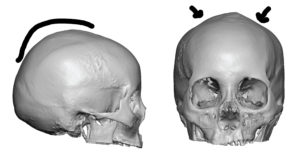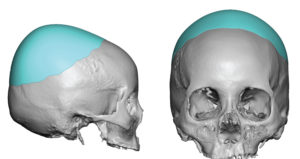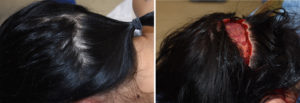Background: The shape of the head in a female has important aesthetic significance. While the concept of having a ‘nice round head’ is perceived as an ideal head shape, the ideal woman’s head shape is much more of an oblong shape. But the area over the crown of the head is of particular significance as it should be the highest peak of the skull in women. This is quite unlike men who would view such a location of maximal skull height as an unaesthetic protrusion.
Why women like a more prominent crown of the head is not precisely clear. At the least they do not like a crown area that is flatter or lacks projection. It may be its appeal from is influence on how it pushes the hair upward. This is suggested because many women who undergo crown augmentation talk of the tedious nature of teasing their hair to look like they have a higher crown area of the head.
Creating a higher crown of the head can only be done by building up the skull. Between bone cements and implants, these are the only two effective augmentation options. While fat grafting has become popular for injectable soft tissue augmentation, this technique will not work for skull augmentation as the scalp is too tight to be pushed outward by the soft consistency of fat. Custom made implants from the patient’s 3D CT scan has become the most effective technique to ensure the best augmentation shape and the desired area of skull coverage.




A custom skull implant is the most assured method for a higher crown area for women, creating the so called ‘bumpit’ effect. The firm composition of the implant provides the best push on the overlying scalp creating a permanent long-term augmentation effect.
Highlights:
1) The flat back or crown of the head is the common location for aesthetic skull augmentation.
2) The maximum thickness of the implant’s central projection and the amount of skull augmentation possible is controlled by how much the scalp can stretch to accommodate it.
3) Custom skull implants provide a ‘bump it’ effect for females.
Dr. Barry Eppley
Indianapolis, Indiana


